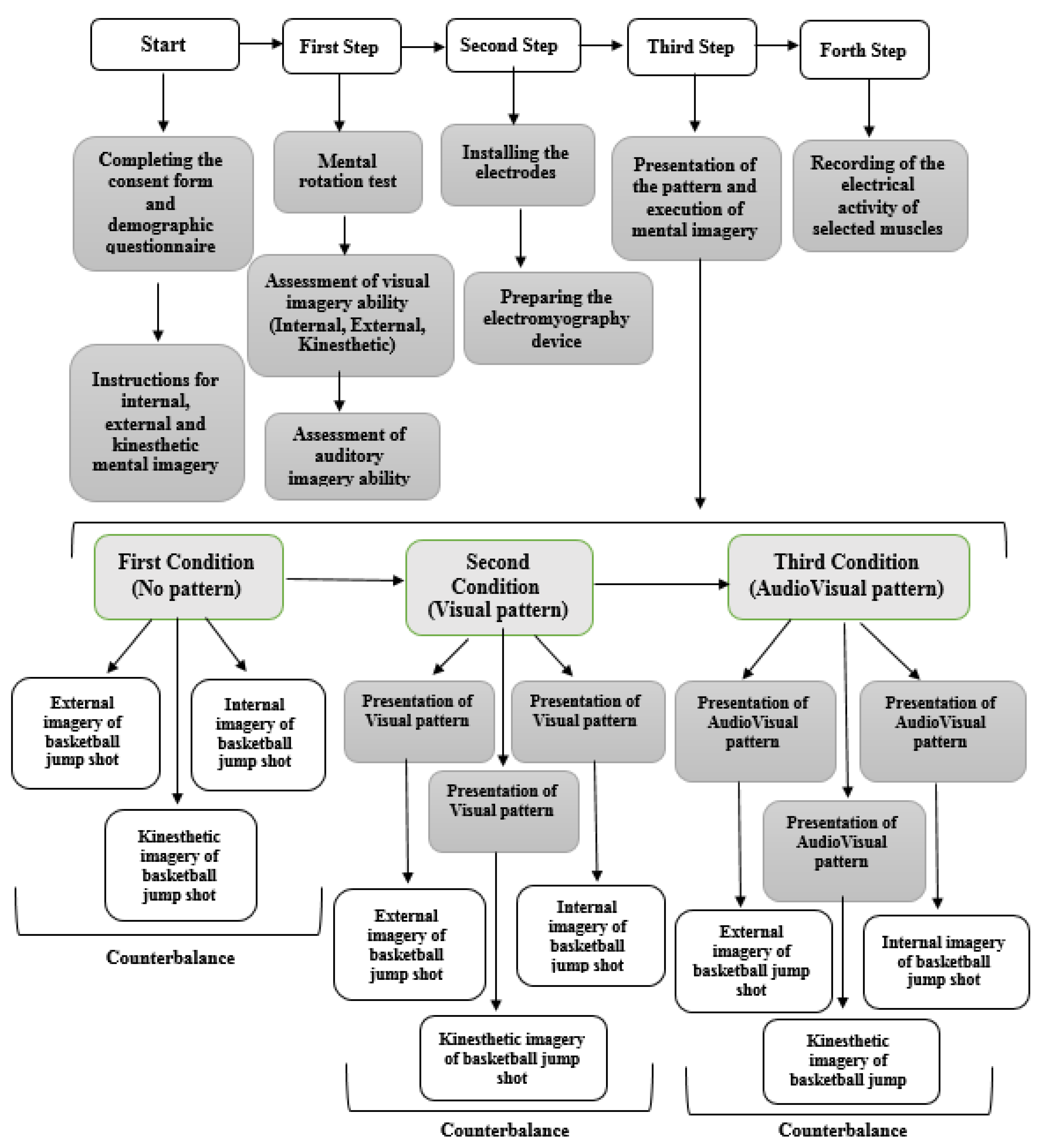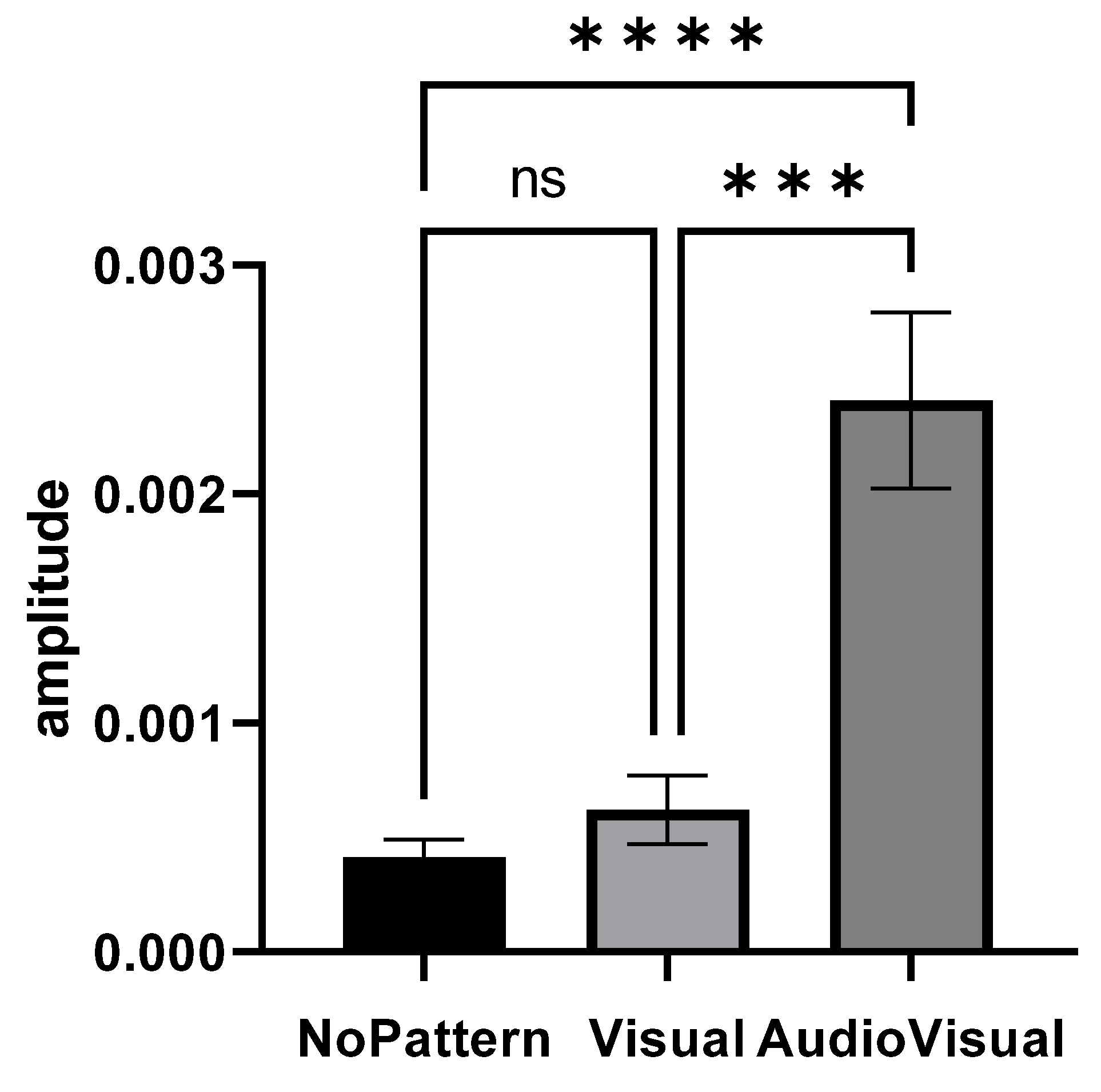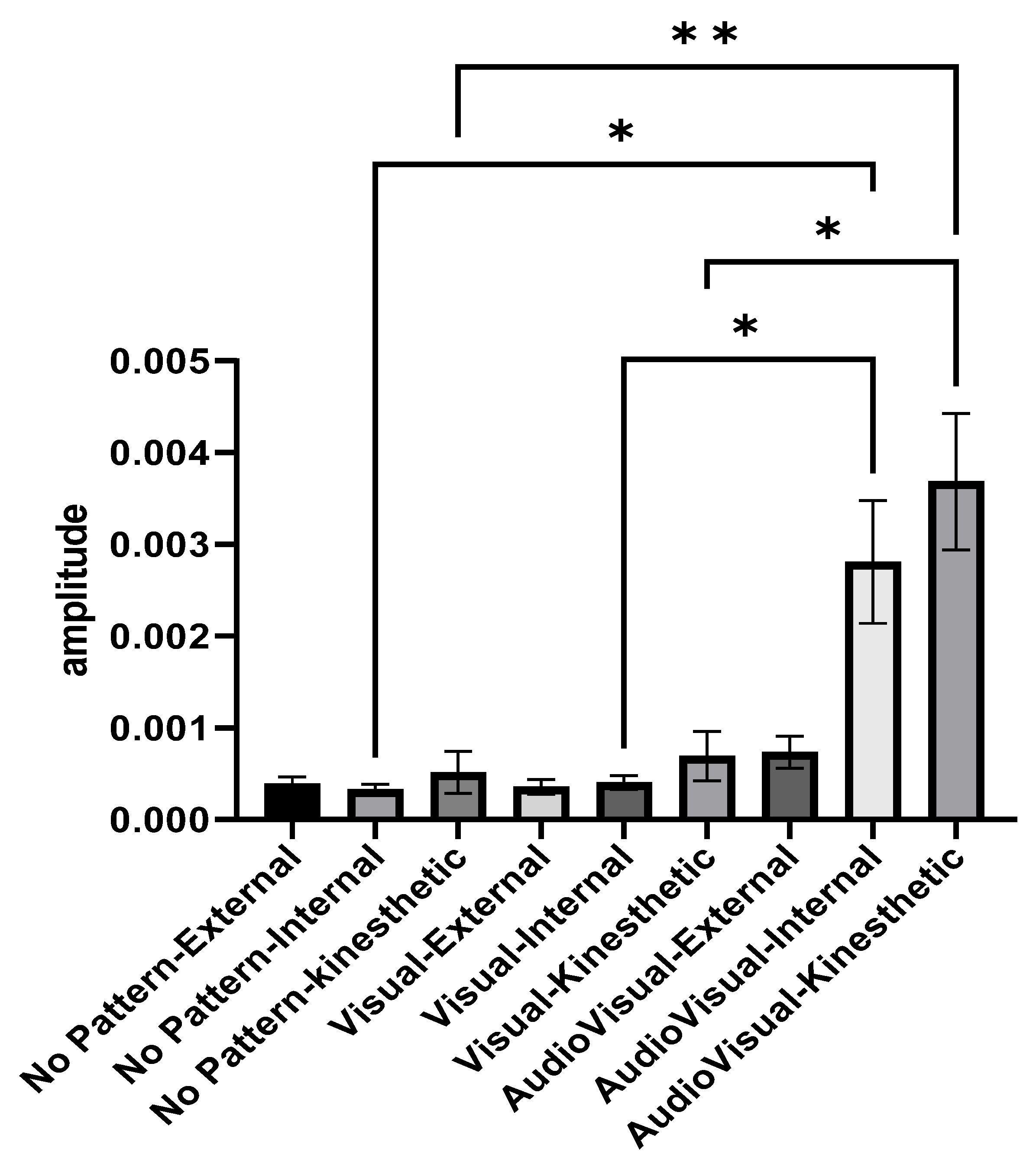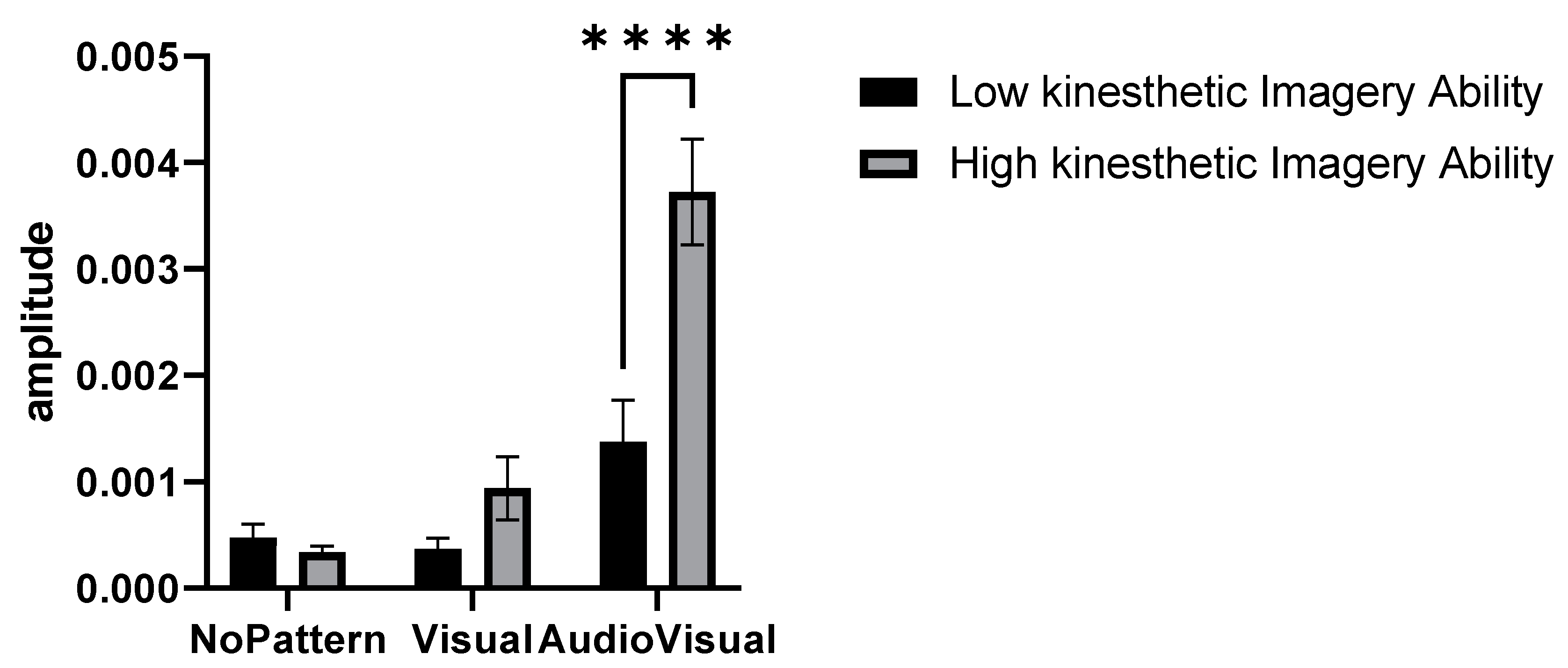Sonification of Motor Imagery in the Basketball Jump Shot: Effect on Muscle Activity Amplitude
Abstract
1. Introduction
2. Materials and Methods
2.1. Participants
2.2. Measures
2.2.1. Mental Rotation Test (MRT)
2.2.2. Movement Imagery Questionnaire-3 (External, Internal, Kinesthetic) (MIQ-3)
2.2.3. Bucknell Auditory Imagery Scale (Vividness and Control)
2.3. Visual and Visual–Auditory Pattern
2.3.1. Visual Pattern
2.3.2. Auditory Pattern
2.4. Procedures
Recording and Analyzing the Electrical Activity of Muscles
2.5. Statistical Analysis
3. Results
4. Discussion
5. Conclusions
Author Contributions
Funding
Institutional Review Board Statement
Informed Consent Statement
Data Availability Statement
Acknowledgments
Conflicts of Interest
References
- Simonsmeier, B.A.; Andronie, M.; Buecker, S.; Frank, C. The effects of imagery interventions in sports: A meta-analysis. Int. Rev. Sport Exerc. Psychol. 2021, 14, 186–207. [Google Scholar] [CrossRef]
- Murphy, S.M.; Martin, K.A. The use of imagery in sport. In Advances in Sport Psychology; Human Kinetics: Champaign, IL, USA, 2002. [Google Scholar]
- Iacono, A.D.; Ashcroft, K.; Zubac, D. Ain’t Just Imagination! Effects of Motor Imagery Training on Strength and Power Performance of Athletes during Detraining. Med. Sci. Sports Exerc. 2021, 53, 2324–2332. [Google Scholar] [CrossRef]
- Behrendt, F.; Zumbrunnen, V.; Brem, L.; Suica, Z.; Gäumann, S.; Ziller, C.; Gerth, U.; Schuster-Amft, C. Effect of Motor Imagery Training on Motor Learning in Children and Adolescents: A Systematic Review and Meta-Analysis. Int. J. Environ. Res. Public Health 2021, 18, 9467. [Google Scholar] [CrossRef] [PubMed]
- Jacobson, E. Electrical measurements of neuromuscular states during mental activities: V. Variation of specific muscles contracting during imagination. Am. J. Physiol. 1931, 96, 115–121. [Google Scholar] [CrossRef]
- Richardson, A. Mental practice: A review and discussion part I. Res. Q. Am. Assoc. Health Phys. Educ. 1967, 38, 95–107. [Google Scholar] [CrossRef]
- Decety, J.; Ingvar, D.H. Brain structures participating in mental simulation of motor behavior: A neuropsychologiacal interpretation. Acta Psychol. 1990, 73, 13–34. [Google Scholar] [CrossRef] [PubMed]
- Kobelt, M.; Wirth, B.; Schuster-Amft, C. Muscle Activation during Grasping with and without Motor Imagery in Healthy Volunteers and Patients after Stroke or with Parkinson’s Disease. Front. Psychol. 2018, 9, 597. [Google Scholar] [CrossRef]
- Lebon, F.; Guillot, A.; Collet, C. Increased Muscle Activation Following Motor Imagery During the Rehabilitation of the Anterior Cruciate Ligament. Appl. Psychophysiol. Biofeedback 2011, 37, 45–51. [Google Scholar] [CrossRef]
- Losana-Ferrer, A.; Manzanas-López, S.; Cuenca-Martínez, F.; Paris-Alemany, A.; La Touche, R. Effects of motor imagery and action observation on hand grip strength, electromyographic activity and intramuscular oxygenation in the hand gripping gesture: A randomized controlled trial. Hum. Mov. Sci. 2018, 58, 119–131. [Google Scholar] [CrossRef]
- Hardwick, R.M.; Caspers, S.; Eickhoff, S.B.; Swinnen, S.P. Neural correlates of action: Comparing meta-analyses of imagery, observation, and execution. Neurosci. Biobehav. Rev. 2018, 94, 31–44. [Google Scholar] [CrossRef]
- Oh, D.; Choi, J. Effects of Motor Imagery Training on Balance and Gait in Older Adults: A Randomized Controlled Pilot Study. Int. J. Environ. Res. Public Health 2021, 18, 650. [Google Scholar] [CrossRef]
- Lutz, R.S. Covert muscle excitation is outflow from the central generation of motor imagery. Behav. Brain Res. 2003, 140, 149–163. [Google Scholar] [CrossRef] [PubMed]
- Guillot, A.; Nadrowska, E.; Collet, C. Using Motor Imagery to Learn Tactical Movements in Basketball. J. Sport Behav. 2009, 32. [Google Scholar]
- Vealey, R.S.; Greenleaf, C.A. Seeing is believing: Understanding and using imagery in sport. Appl. Sport Psychol. Pers. Growth Peak Perform. 2010, 4, 247–272. [Google Scholar]
- Finks, R.A.; Pinker, S.; Farah, M.J. Reinterpreting visual patterns in mental imagery. Cogn. Sci. 1989, 13, 51–78. [Google Scholar] [CrossRef]
- Reisberg, D.; Heuer, F. Visuospatial Images; Cambridge University Press: Cambridge, UK, 2005. [Google Scholar]
- Schaefer, R.S. Images of time: Temporal aspects of auditory and movement imagination. Front. Media SA 2014, 5, 877. [Google Scholar] [CrossRef]
- Stevenson, R.J.; Case, T.I. Olfactory imagery: A review. Psychon. Bull. Rev. 2005, 12, 244–264. [Google Scholar] [CrossRef] [PubMed]
- Eardley, A.F.; Pring, L. Remembering the past and imagining the future: A role for nonvisual imagery in the everyday cognition of blind and sighted people. Memory 2006, 14, 925–936. [Google Scholar] [CrossRef] [PubMed]
- Plailly, J.; Delon-Martin, C.; Royet, J.-P. Experience induces functional reorganization in brain regions involved in odor imagery in perfumers. Hum. Brain Mapp. 2011, 33, 224–234. [Google Scholar] [CrossRef]
- Schmidt, T.T.; Ostwald, D.; Blankenburg, F. Imaging tactile imagery: Changes in brain connectivity support per-ceptual grounding of mental images in primary sensory cortices. Neuroimage 2014, 98, 216–224. [Google Scholar] [CrossRef]
- Schaefer, R.S.; Vlek, R.J.; Desain, P. Music perception and imagery in EEG: Alpha band effects of task and stimulus. Int. J. Psychophysiol. 2011, 82, 254–259. [Google Scholar] [CrossRef] [PubMed]
- White, K.D.; Ashton, R.; Brown, R.M.D. The measurement of imagery vividness: Normative data and their relationship to sex, age, and modality differences. Br. J. Psychol. 1977, 68, 203–211. [Google Scholar] [CrossRef]
- Olivetti Belardinelli, M.; Palmiero, M.; Sestieri, C.; D’Ausilio, A.; Di Matteo, R.; Londei, A.; D’Ausilio, A.; Ferretti, A.; Del Gratta, C.; Romani, G.L. An fMRI investigation on image generation in different sensory modalities: The influence of vividness. Acta Psycholl. 2007, 132, 190–200. [Google Scholar] [CrossRef] [PubMed]
- Su, Y.-H.; Pöppel, E. Body movement enhances the extraction of temporal structures in auditory sequences. Psychol. Res. 2011, 76, 373–382. [Google Scholar] [CrossRef]
- Bood, R.J.; Nijssen, M.; van der Kamp, J.; Roerdink, M. The Power of Auditory-Motor Synchronization in Sports: Enhancing Running Performance by Coupling Cadence with the Right Beats. PLoS ONE 2013, 8, e70758. [Google Scholar] [CrossRef]
- Keller, P.E.; Appel, M. Individual Differences, Auditory Imagery, and the Coordination of Body Movements and Sounds in Musical Ensembles. Music. Percept. 2010, 28, 27–46. [Google Scholar] [CrossRef]
- Pecenka, N.; Keller, P.E. Auditory Pitch Imagery and Its Relationship to Musical Synchronization. Ann. New York Acad. Sci. 2009, 1169, 282–286. [Google Scholar] [CrossRef]
- Repp, B.H. Effects of music perception and imagery on sensorimotor synchronization with complex timing patterns. Ann. New York Acad. Sci. 2001, 930, 409–411. [Google Scholar] [CrossRef]
- Intons-Peterson, M.J. Components of auditory imagery. Audit. Imag. 1992, 45–72. [Google Scholar]
- Hale, B.; Crisfield, P. Imagery Training: A Guide for Sports Coaches and Performers; Coachwise 1st4sport: Leeds, UK, 2005. [Google Scholar]
- Calmels, C.; Holmes, P.S.; Berthoumieux, C.; Singer, R.N. The development of movement imagery vividness through a structured intervention in softball. J. Sport Behav. 2004, 27, 307–322. [Google Scholar]
- Smith, D.; Holmes, P. The Effect of Imagery Modality on Golf Putting Performance. J. Sport Exerc. Psychol. 2004, 26, 385–395. [Google Scholar] [CrossRef]
- Debarnot, U.; Guillot, A. When music tempo affects the temporal congruence between physical practice and motor imagery. Acta Psychol. 2014, 149, 40–44. [Google Scholar] [CrossRef] [PubMed]
- Hermann, T.; Hunt, A.; Neuhoff, J.G. The Sonification Handbook; Logos Verlag: Berlin, Germany, 2011. [Google Scholar]
- Welch, R.B.; Warren, D.H. Immediate perceptual response to intersensory discrepancy. Psychol. Bull. 1980, 88, 638. [Google Scholar] [CrossRef]
- Vinken, P.M.; Kröger, D.; Fehse, U.; Schmitz, G.; Brock, H.; Effenberg, A.O. Auditory Coding of Human Movement Kinematics. Multisensory Res. 2013, 26, 533–552. [Google Scholar] [CrossRef] [PubMed]
- Effenberg, A.O. Movement Sonification: Effects on Perception and Action. IEEE MultiMed. 2005, 12, 53–59. [Google Scholar] [CrossRef]
- Kaiser, R.; Medeiros, C.B.; Wanderley, M.M.; Schönwiesner, M. The effect of movement-complexity on perceived audio-visual synchronicity. J. Vis. 2014, 14, 1016. [Google Scholar] [CrossRef]
- Ramezanzade, H.; Abdoli, B.; Farsi, A.; Sanjari, M.A. The effect of sonification modelling on perception and accuracy of performing jump shot basketball. Int. J. Sport. Stud. 2014, 4, 1388–1392. [Google Scholar]
- Effenberg, A.O.; Fehse, U.; Schmitz, G.; Krueger, B.; Mechling, H. Movement Sonification: Effects on Motor Learning beyond Rhythmic Adjustments. Front. Neurosci. 2016, 10, 219. [Google Scholar] [CrossRef]
- Effenberg, A.; Fehse, U.; Weber, A. Movement Sonification: Audiovisual benefits on motor learning. BIO Web Conf. 2011, 1, 00022. [Google Scholar] [CrossRef]
- Ramezanzade, H.; Abdoli, B.; Farsi, A.; Sanjari, M.A. The effect of audiovisual integration on performance accuracy and learning in motor task. J. Res. Rehabil. Sci. 2015, 11, 1–10. [Google Scholar]
- Holmes, P.S.; Collins, D.J. The PETTLEP Approach to Motor Imagery: A Functional Equivalence Model for Sport Psychologists. J. Appl. Sport Psychol. 2001, 13, 60–83. [Google Scholar] [CrossRef]
- Hall, C.R.; Rodgers, W.M.; Barr, K.A. The Use of Imagery by Athletes in Selected Sports. Sport Psychol. 1990, 4, 1–10. [Google Scholar] [CrossRef]
- Hardy, L.; Callow, N. Efficacy of external and internal visual imagery perspectives for the enhancement of per-formance on tasks in which form is important. J. Sport Exerc. Psychol. 1999, 21, 95–112. [Google Scholar] [CrossRef]
- Mahoney, M.J.; Avener, M. Psychology of the elite athlete: An exploratory study. Cogn. Ther. Res. 1977, 1, 135–141. [Google Scholar] [CrossRef]
- Shepard, R.N.; Metzler, J. Mental Rotation of Three-Dimensional Objects. Science 1971, 171, 701–703. [Google Scholar] [CrossRef] [PubMed]
- Peters, M.; Laeng, B.; Latham, K.; Jackson, M.; Zaiyouna, R.; Richardson, C. A Redrawn Vandenberg and Kuse Mental Rotations Test—Different Versions and Factors that Affect Performance. Brain Cogn. 1995, 28, 39–58. [Google Scholar] [CrossRef]
- Williams, S.E.; Cumming, J.; Ntoumanis, N.; Nordin-Bates, S.M.; Ramsey, R.; Hall, C. Further validation and de-velopment of the movement imagery questionnaire. J. Sport Exerc. Psychol. 2012, 34, 621–646. [Google Scholar] [CrossRef]
- Wilson, C.; Smith, D.; Burden, A.; Holmes, P. Participant-generated imagery scripts produce greater EMG activity and imagery ability. Eur. J. Sport Sci. 2010, 10, 417–425. [Google Scholar] [CrossRef]
- Sohrabi, M.; Farsi, A.; Foladian, J. Determining the validity and reliability of the Persian version of the revised movement imaging questionnaire. Mot. Behav. 2010, 2, 13–24. [Google Scholar]
- Halpern, A.R. Differences in auditory imagery self-report predict neural and behavioral outcomes. Psychomusicol. Music. Mind Brain 2015, 25, 37–47. [Google Scholar] [CrossRef]
- Filgueiras, A.; Francisco, E.; Conde, Q.; Hall, C.R. The neural basis of kinesthetic and visual imagery in sports: An ALE meta-analysis. Brain Imaging Behav. 2018, 12, 1513–1523. [Google Scholar] [CrossRef] [PubMed]
- Callow, N.; Jiang, D.; Roberts, R.; Edwards, M.G. Kinesthetic Imagery Provides Additive Benefits to Internal Visual Imagery on Slalom Task Performance. J. Sport Exerc. Psychol. 2017, 39, 81–86. [Google Scholar] [CrossRef] [PubMed]
- Chholak, P.; Niso, G.; Maksimenko, V.A.; Kurkin, S.A.; Frolov, N.S.; Pitsik, E.N.; Hramov, A.E.; Pisarchik, A.N. Visual and kinesthetic modes affect motor imagery classification in untrained subjects. Sci. Rep. 2019, 9, 9838. [Google Scholar] [CrossRef] [PubMed]
- Lebon, F.; Horn, U.; Domin, M.; Lotze, M. Motor imagery training: Kinesthetic imagery strategy and inferior parietal fMRI activation. Hum. Brain Mapp. 2018, 39, 1805–1813. [Google Scholar] [CrossRef]
- Heremans, E.; Helsen, W.F.; De Poel, H.J.; Alaerts, K.; Meyns, P.; Feys, P. Facilitation of motor imagery through movement-related cueing. Brain Res. 2009, 1278, 50–58. [Google Scholar] [CrossRef] [PubMed]
- Halpern, A.R.; Zatorre, R.J. When that tune runs through your head: A PET investigation of auditory imagery for familiar melodies. Cereb. Cortex 1999, 9, 697–704. [Google Scholar] [CrossRef]
- Keller, P.E.; Bella, S.D.; Koch, I. Auditory imagery shapes movement timing and kinematics: Evidence from a musical task. J. Exp. Psychol. Hum. Percept. Perform. 2010, 36, 508–513. [Google Scholar] [CrossRef]
- Colley, I.D.; Keller, P.E.; Halpern, A.R. Working memeory and auditory imagery predict sensorimotor synchro-nization with expressively timed music. Q. J. Exp. Psychol. 2018, 71, 1781–1796. [Google Scholar] [CrossRef]
- Schmitz, G.; Mohammadi, B.; Hammer, A.; Heldmann, M.; Samii, A.; Münte, T.F.; Effenberg, A.O. Observation of sonified movements engages a basal ganglia frontocortical network. BMC Neurosci. 2013, 14, 32. [Google Scholar] [CrossRef]
- Lahav, A.; Saltzman, E.; Schlaug, G. Action Representation of Sound: Audiomotor Recognition Network While Listening to Newly Acquired Actions. J. Neurosci. 2007, 27, 308–314. [Google Scholar] [CrossRef]
- Hubbard, T.L. Auditory imagery: Empirical findings. Psychol. Bull. 2010, 136, 302–329. [Google Scholar] [CrossRef] [PubMed]
- Zatorre, R.J.; Halpern, A.R.; Bouffard, M. Mental Reversal of Imagined Melodies: A Role for the Posterior Parietal Cortex. J. Cogn. Neurosci. 2010, 22, 775–789. [Google Scholar] [CrossRef]
- Schmitz, G.; Effenberg, A.O. Perceptual effects of auditory information about own and other movements. In Proceedings of the 18th International Conference on Auditory Display, Atlanta, GA, USA, 18–21 June 2012. [Google Scholar]
- Castro, F.; Bryjka, P.A.; Pino, G.D.; Vuckovic, A.; Nowicky, A.; Bishop, D. Sonification of combined action obser-vation and motor imagery: Effect on corticospinal exitability. Brain Cogn. 2021, 152, 57–68. [Google Scholar] [CrossRef] [PubMed]
- Rodgers, W.; Hall, C.; Buckolz, E. The effect of an imagery training program on imagery ability, imagery use, and figure skating performance. J. Appl. Sport Psychol. 1991, 3, 109–125. [Google Scholar] [CrossRef]
- Dana, A.; Gozalzadeh, E. Internal and External Imagery Effects on Tennis Skills Among Novices. Percept. Mot. Ski. 2017, 124, 1022–1043. [Google Scholar] [CrossRef] [PubMed]
- Sobierajewicz, J.; Przekoracka-Krawczyk, A.; Jaśkowski, W.; Verwey, W.B.; van der Lubbe, R. The influence of motor imagery on the learning of a fine hand motor skill. Exp. Brain Res. 2016, 235, 305–320. [Google Scholar] [CrossRef]





Disclaimer/Publisher’s Note: The statements, opinions and data contained in all publications are solely those of the individual author(s) and contributor(s) and not of MDPI and/or the editor(s). MDPI and/or the editor(s) disclaim responsibility for any injury to people or property resulting from any ideas, methods, instructions or products referred to in the content. |
© 2023 by the authors. Licensee MDPI, Basel, Switzerland. This article is an open access article distributed under the terms and conditions of the Creative Commons Attribution (CC BY) license (https://creativecommons.org/licenses/by/4.0/).
Share and Cite
Ramezanzade, H.; Badicu, G.; Cataldi, S.; Parimi, F.; Mohammadzadeh, S.; Mohamadtaghi, M.; Zamani Sani, S.H.; Greco, G. Sonification of Motor Imagery in the Basketball Jump Shot: Effect on Muscle Activity Amplitude. Appl. Sci. 2023, 13, 1495. https://doi.org/10.3390/app13031495
Ramezanzade H, Badicu G, Cataldi S, Parimi F, Mohammadzadeh S, Mohamadtaghi M, Zamani Sani SH, Greco G. Sonification of Motor Imagery in the Basketball Jump Shot: Effect on Muscle Activity Amplitude. Applied Sciences. 2023; 13(3):1495. https://doi.org/10.3390/app13031495
Chicago/Turabian StyleRamezanzade, Hesam, Georgian Badicu, Stefania Cataldi, Fateme Parimi, Sahar Mohammadzadeh, Mahya Mohamadtaghi, Seyed Hojjat Zamani Sani, and Gianpiero Greco. 2023. "Sonification of Motor Imagery in the Basketball Jump Shot: Effect on Muscle Activity Amplitude" Applied Sciences 13, no. 3: 1495. https://doi.org/10.3390/app13031495
APA StyleRamezanzade, H., Badicu, G., Cataldi, S., Parimi, F., Mohammadzadeh, S., Mohamadtaghi, M., Zamani Sani, S. H., & Greco, G. (2023). Sonification of Motor Imagery in the Basketball Jump Shot: Effect on Muscle Activity Amplitude. Applied Sciences, 13(3), 1495. https://doi.org/10.3390/app13031495








